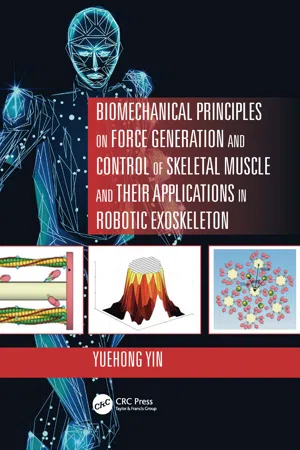
Biomechanical Principles on Force Generation and Control of Skeletal Muscle and their Applications in Robotic Exoskeleton
- 360 pages
- English
- ePUB (mobile friendly)
- Available on iOS & Android
Biomechanical Principles on Force Generation and Control of Skeletal Muscle and their Applications in Robotic Exoskeleton
About This Book
This book systematically introduces the bionic nature of force sensing and control, the biomechanical principle on mechanism of force generation and control of skeletal muscle, and related applications in robotic exoskeleton.
The book focuses on three main aspects: muscle force generation principle and biomechanical model, exoskeleton robot technology based on skeletal muscle biomechanical model, and SMA-based bionic skeletal muscle technology.
This comprehensive and in-depth book presents the author's research experience and achievements of many years to readers in an effort to promote academic exchanges in this field.
About the Author
Yuehong Yin received his B.E., M.S. and Ph.D. degrees from Nanjing University of Aeronautics and Astronautics, Nanjing, in 1990, 1995 and 1997, respectively, all in mechanical engineering. From December 1997 to December 1999, he was a Postdoctoral Fellow with Zhejiang University, Hangzhou, China, where he became an Associate Professor in July 1999. Since December 1999, he has been with the Robotics Institute, Shanghai Jiao Tong University, Shanghai, China, where he became a Professor and a Tenure Professor in December 2005 and January 2016, respectively. His research interests include robotics, force control, exoskeleton robot, molecular motor, artificial limb, robotic assembly, reconfigurable assembly system, and augmented reality. Dr. Yin is a fellow of the International Academy of Production Engineering (CIRP).
Frequently asked questions
Information
1 | Force Generation Mechanism of Skeletal Muscle Contraction |
1.1ANATOMY OF SKELETAL MUSCLE
1.1.1MACROSTRUCTURE

1.1.2MESOSTRUCTURE
1.1.3MICROSTRUCTURE

Table of contents
- Cover
- Half Title
- Series Page
- Title Page
- Copyright Page
- Table of Contents
- Foreword
- Author
- Chapter 1 Force Generation Mechanism of Skeletal Muscle Contraction
- Chapter 2 Biomechanical Modeling of Muscular Contraction
- Chapter 3 Estimation of Skeletal Muscle Activation and Contraction Force Based on EMG Signals
- Chapter 4 Human–Machine Force Interactive Interface and Exoskeleton Robot Techniques Based on Biomechanical Model of Skeletal Muscle
- Chapter 5 Clinical Rehabilitation Technologies for Force-Control–Based Exoskeleton Robot
- Chapter 6 Bionic Design of Artificial Muscle Based on Biomechanical Models of Skeletal Muscle
- Conclusion
- Index